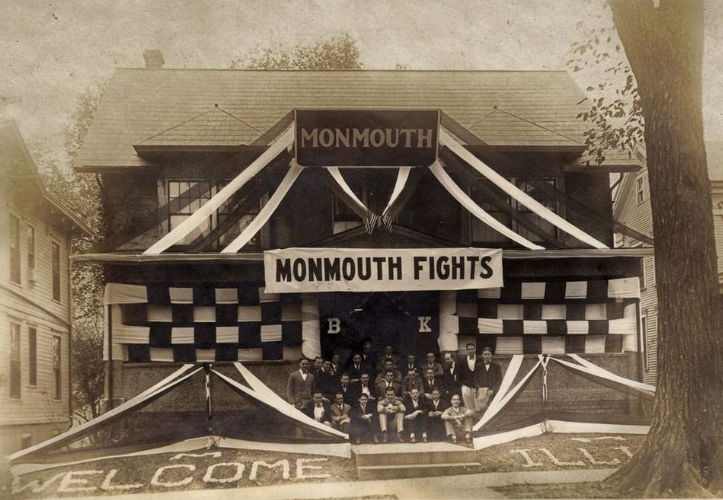Origins of Beta Pi Chapter at Monmouth College
The following article was published on May 28, 2019, via the Daily Review Atlas (www.reviewatlas.com). It was reprinted with permission from Jeff Rankin, the author of the article, which depicts the early history of Beta Pi/Monmouth.
Jeff Rankin: Photos illustrate chapter in MC fraternity history
Today’s column was inspired by two 93-year-old photographs of houses on East Broadway that recently came into my possession.
Taken by Monmouth photographer and postcard publisher Scott B. McQuown in October 1926, the photos show two former Monmouth College fraternity houses decorated for Homecoming. At the time, both were local fraternities in the process of becoming national fraternities, and that is the subject of today’s column.
The houses, located at 309 East Broadway and 620 East Broadway (no longer standing), were emblematic of a time following World War I, when there was a loosening of rigid Victorian morals and young men hardened by war were eager to embrace the more carefree and independent lifestyle of the Roaring Twenties. Fraternity houses at Monmouth also emerged out of necessity, as no dormitories for male students would be available until 1946.

The history of Greek life at Monmouth College is both long and proud, but it is also remarkably complicated, due to a Presbyterian Church edict against secret societies that caused the college Senate to ban fraternities from campus for nearly half a century.
Greek-letter organizations at Monmouth began immediately after the Civil War, when returning veterans were granted charters in 1865 by the national fraternities Delta Tau Delta and Beta Theta Pi. Monmouth’s pioneering women’s fraternities, Pi Beta Phi and Kappa Kappa Gamma, were organized in 1867 and 1870, respectively. Phi Gamma Delta was founded in 1869. Phi Kappa Psi and Phi Delta Theta were installed in 1871. An interesting note about the Phi Delta Theta chapter is that it inducted future renowned poet Eugene Field, although he was at the time a student at Knox College.
Chapters of Kappa Phi Lambda and the Phi Sigma League existed briefly prior to 1874. In 1874 a chapter of Sigma Chi was chartered.
Monmouth College was founded as an academy in 1853 by the Second Presbytery of Illinois. As early as 1829, the Presbyterian Synod had been concerned about the growing popularity of secret societies (e.g., Freemasonry and Odd Fellows), primarily because they were perceived to require binding oneself to membership by an oath. According to the Church’s Confession, “Whosoever taketh an oath, ought duly to consider the weightiness of so solemn an act, and therein to avouch nothing but what he is fully persuaded is the truth...”
After the Civil War, prominent preachers like Jonathan Blanchard launched national campaigns against secret societies, which Blanchard had banned at Wheaton College when he became its president in 1860. Princeton University had banned Greek-letter organizations as early as 1853. After the founding of the Anti-Masonic Party by Blanchard in 1872, pressure on religious-affiliated colleges to cleanse themselves of secret societies became intense.
By a resolution of the Monmouth College Senate in 1874, all students who were members of fraternities were required to renounce their membership. President David Wallace, who was a fraternity man himself, opted to not rigidly enforce the ban, so some of Monmouth’s fraternities continued to operate quietly for several years—the last chapter finally relinquishing its charter in 1885 under increasing pressure from the Senate.
In 1887, seven Monmouth College students secretly organized Phi Kappa Pi, under the leadership of future Illinois Senator Clarence F. Buck. Meetings were held in vacant houses, store rooms and barns. In 1890, just before the graduation of two of the founders, the fraternity was organized and a new name chosen. From 1890-1892 it became Theta Sigma Phi, but was commonly known as “Big Eight.” In 1902, anti-fraternity regulations became more severe. Theta Sigma Phi had become notorious, so the original name was readopted.
The independent spirit of Monmouth women who organized Pi Beta Phi reemerged in 1899 with the founding of a local sub-rosa chapter called Zeta Epsilon Chi. The following year, Kappa Alpha Sigma became a local sub-rosa chapter of Kappa Kappa Gamma.
In 1903, a group of 10 women students organized an informal social group called the Fidos, which in 1906 was converted into a local sorority named Phi Delta Sigma. In 1909, the Senate voted all social organizations off campus and Phi Delta Sigma formally disbanded, but a new sorority, Alpha Beta Gamma soon arose.
In 1907, 11 men organized Tau Lambda Phi. In 1910, although off campus, it successfully petitioned one of the oldest national fraternities—Pi Rho Phi—for a charter and became its western-most chapter. Gradually, however, other colleges’ chapters were disbanded, leaving Monmouth’s the only one left to uphold Pi Rho Phi traditions. It would later be folded into Theta Upsilon Omega fraternity, which still later merged into Sigma Phi Epsilon.
Another local fraternity, Phi Sigma Alpha, was founded in 1908, when five members of the Philadelphian Literary Society banded together. Although sub rosa, it showed steady growth. On April 6, 1917, the day war was declared on Germany, it held its eighth annual banquet, and before the end of that spring nearly all members had enlisted in the service.
Similarly, another local fraternity—Xi Gamma Delta—was founded in 1914, but lapsed until 1920, when its entire membership had been drawn into World War I.
In 1922, the college Senate voted to recognize local fraternities, but it was not until 1925 that they were allowed to petition national fraternities for charters. In the spring of 1926, Xi Gamma Delta petitioned the national fraternity Beta Kappa for a charter, and in 1927, Phi Sigma Alpha petitioned Tau Kappa Epsilon for a chapter.
Today’s 1926 photos represent a moment in Monmouth College history that bridged the brief era between the end of local fraternities and the reinstatement of national fraternities on campus.
You may view the original article by clicking here.



